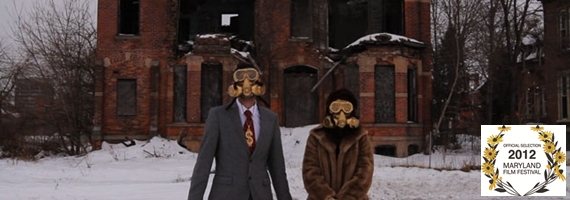This screening was one of the few that were to be held a few streets away at the Brown Center at the MICA campus. Talk about an astonishingly gorgeous room for a documentary; bold colors, great sound and presentation, and space of course for the director to say a few words. The oscar-nominated director, Rachel Grady (Jesus Camp) took the stage to praise the Maryland Film Festival (like many did) and…
Powerful and astounding are two words that cannot be used enough to describe the stories and lives shown in this powerful and astounding documentary. The film begins with a few Detroit youth exploring old decrepit buildings that over populate the city. From there, we take a look at the lives of a blogger, an artist, a Union President, a bar owner, and we even get an unprecedented look into the Detroit government with a few scenes that take place during an Mayor’s meeting with city planners. The film does so much more than chronicle the lives of a few living in a dying city; it shows you nearly every facet of the dying city and the ruins it’s leaving behind. The city itself looks gorgeous in this tremendously beautiful documentary as it crawls and climbs it way through grandioso buildings that now lay dormant and stoic like an archaeologists dig site. Some of the most gorgeous and profound moments are the moments when the film is quiet. You hear nothing but you see the quiet decay and you feel the heartache pouring from these once lively buildings.
Those handfuls of scenes are interlaced between the lives of some who see Detroit falling into collapse while others see this city as a breeding ground for new youth and art movements. Sadly, they are both correct. Through the life of the Auto Workers Union President, we see a struggle to keep well paying jobs in Detroit for those who need it and we’re introduced to a local bar owner who gets the shortest end of that stick because if the jobs go away, the workers don’t have the money to spend at the local bar, and that local bar will be no more. The bar owner is the most colorful of the citizens in this Dickensian piece as he travels around old neighborhoods and even makes startling discoveries at the annual car show in Detroit. But while we see the working class deal with whats becoming of their city, we also get a surprising look inside the Detroit government. The Mayor is on the losing side and things aren’t looking any better. Their stats are plummeting and the answers he wants to give, he can’t afford. Some of his proposals face backlash as showcased in a few town hall meetings.
But while all this sorrow and doubt is happening, few are rejoicing. The artist in the film, who in my opinion we don’t see enough of, discusses how inexpensive it is and how freeing it is to live in Detroit and all the potential that lies at their feet. Even the blogger sees the hope in what the city can provide. This vivid portrait struck a few chords in me, some of the same chords that made me move to New Orleans, and showed me that a lot of cities still need help. This film is the shot in the arm this country needs to see not only where we are, but also where we might be headed if things do not get better. I would be shocked if at some point this film was not picked up and added to the Criterion Collection library. Seek out this film and see it in theatres if you get the chance.
The obvious question that started off the Q&A was why Detroit? Director Rachel Grady has been to Detroit before and the more she goes back to visit the more she’s been noticing that the city is becoming more and more empty. Co-Director Heidi Ewing, whom could not make it to the festival, is from Detroit and her father works in the manufacturing business there so it was a very personal subject for her. The gorgeous, yet poignant, shots of the city and it’s decay were found through various city postings and lists for demolition. An audience member asked why there was no mention or footage of the “1%”. The director chuckled and explained that they wanted to talk to heads of corporations and one agreed, but the catch was that he would get the right to edit out what he didn’t like. Clearly, the director was not going to give up that power. She also said this wasn’t a Michael Moore film where he would be in their face about it. They received access to the Mayoral Office meeting after bugging his camp repeatedly, but after the meeting they filmed, they were not allowed back to film. Individuals from the Mayors camp don’t want to see the film nor do they like it because it’s painful for them. However, says Grady, they found the footage and overall message of the film to be true and something they can no longer hide. Many audience members offered emotional thank you’s for making such a breathtaking film and for bringing such an issue to the forefront. The most important question was when an audience member asked what was left of Detroit after filming and have they returned since. The director made it a point to say the characters in the film show that charismatic believers and youth and bringing hope and vibrancy back to the city, but slowly and in pockets. The directors wanted to show Detroit ad say it still exists but it’s all in danger.







